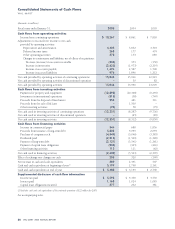Walmart 2005 Annual Report Download - page 33
Download and view the complete annual report
Please find page 33 of the 2005 Walmart annual report below. You can navigate through the pages in the report by either clicking on the pages listed below, or by using the keyword search tool below to find specific information within the annual report. WAL-MART 2005 ANNUAL REPORT 31
and estimates are based on past events and expectations of future
outcomes. Actual results may differ from our estimates.
Management continually reviews its accounting policies, how they
are applied and how they are reported and disclosed in our finan-
cial statements. Following is a summary of our more significant
accounting policies and how they are applied in preparation of the
financial statements.
Inventories
We value our inventories at the lower of cost or market as determined
primarily by the retail method of accounting, using the last-in, first-
out (“LIFO”) method for substantially all merchandise inventories in
the United States, except SAM’S CLUB merchandise, which is based
on average cost using the LIFO method. Inventories for international
operations are primarily valued by the retail method of accounting
and are stated using the first-in, first-out (“FIFO”) method.
Under the retail method, inventory is stated at cost, which is
determined by applying a cost-to-retail ratio to each merchandise
grouping’s retail value. The cost-to-retail ratio is based on the fis-
cal-year purchase activity for each store location. The retail method
requires Management to make certain judgments and estimates that
may significantly impact the ending inventory valuation at cost as
well as the amount of gross margin recognized. Judgments made
include the recording of markdowns used to sell through inven-
tory and shrinkage. Markdowns designated for clearance activity
are recorded at the time of the decision rather than at the point of
sale, when Management determines the salability of inventory has
diminished. Factors considered in the determination of markdowns
include current and anticipated demand, customer preferences, age
of merchandise, as well as seasonal and fashion trends. Changes in
weather patterns and customer preferences related to fashion trends
could cause material changes in the amount and timing of mark-
downs from year to year.
When necessary, the company records a LIFO provision each quar-
ter for the estimated annual effect of inflation, and these estimates are
adjusted to actual results determined at year-end. Our LIFO provi-
sion is calculated based on inventory levels, markup rates and inter-
nally generated retail price indices except for grocery items, for which
we use a consumer price index. At January 31, 2005 and 2004, our
inventories valued at LIFO approximate those inventories if they were
valued at FIFO.
The company provides for estimated inventory losses (“shrinkage”)
between physical inventory counts on the basis of a percentage
of sales. The provision is adjusted annually to reflect the histori-
cal trend of the actual physical inventory count results. Historically,
shrinkage has not been volatile.
Impairment of Assets
We evaluate long-lived assets other than goodwill for indicators of
impairment whenever events or changes in circumstances indicate
their carrying value may not be recoverable. Management’s judg-
ments regarding the existence of impairment indicators are based
on market conditions and our operational performance, such as
operating income and cash flows. The variability of these factors
depends on a number of conditions, including uncertainty about
future events, and thus our accounting estimates may change from
period to period. These factors could cause Management to con-
clude that impairment indicators exist and require that impairment
tests be performed, which could result in Management determining
that the value of long-lived assets is impaired, resulting in a write-
down of the long-lived assets.
Goodwill is evaluated for impairment annually or whenever events
or changes in circumstances indicate that the value of certain good-
will may be impaired. This evaluation requires Management to make
judgments relating to future cash flows, growth rates, economic and
market conditions. These evaluations are based on discounted cash
flows that incorporate the impact of existing company businesses.
Historically, the company has generated sufficient returns to recover
the cost of goodwill and other intangible assets. Because of the nature
of the factors used in these tests, if different conditions occur in
future periods, future operating results could be materially impacted.
Income Taxes
The determination of our provision for income taxes requires sig-
nificant judgment, the use of estimates, and the interpretation and
application of complex tax laws. Significant judgment is required in
assessing the timing and amounts of deductible and taxable items.
We establish reserves when, despite our belief that our tax return
positions are fully supportable, we believe that certain positions may
be successfully challenged. When facts and circumstances change,
we adjust these reserves through our provision for income taxes.
Self-Insurance
We use a combination of insurance, self-insured retention and
self-insurance for a number of risks including workers’ compensa-
tion, general liability, vehicle liability and the company’s portion of
employee-related health care benefits. Liabilities associated with the
risks that we retain are estimated in part by considering historical
claims experience, including frequency, severity, demographic
factors, and other assumptions. In calculating our liability, we analyze
our historical trends, including loss development, and apply appropri-
ate loss-development factors to the incurred costs associated with the
claims made against our self-insured program. The estimated accruals
for these liabilities could be significantly affected if future occurrences
or loss development differ from these assumptions. For example,
for workers’ compensation and liability, a 1% increase or decrease
to the assumptions for claims costs and loss development factors
would increase or decrease our self-insurance accrual by $21 mil-
lion and $53 million, respectively. A 1% increase or decrease in
employee-related health care costs would increase or decrease our
self-insured employee health care expense by $16 million.
























